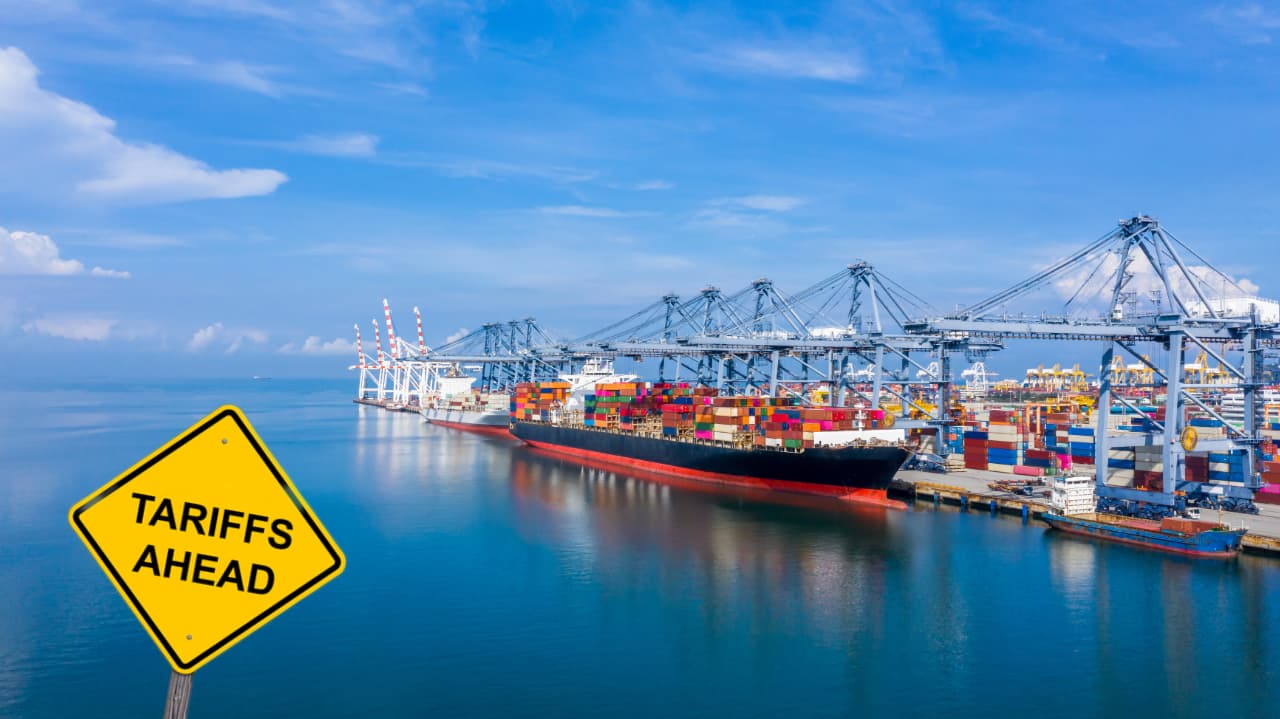
A month on and the tariffs on imported goods imposed by the Trump administration are starting to bite. Here’s where we are so far.
We’re now a month into the global trade wars kicked off by the Trump administration, so it seems like a good time to look at what has been going on so far and what is likely to happen in the future.
The key takeaway is that prices are on their way up. If they aren’t rising yet they will be soon. It’s possibly too early to say whether the children of America will really have to just make do with two dolls instead of 30, and that they might cost a couple of bucks more than they normally would, as President Trump has suggested. But the chances are that anyone in the US looking to buy new camera kit — or technology in general — over the course of the next few months will have to fork out more for it.
Here’s the current state of play.
Cameras and kit
 Blackmagic Design was the first company to publicly raise its prices and the slight chaos surrounding the pricing of its new PYXIS 12K camera reflected the situation at the start of April. The camera was announced with a pre-order price of $4995 on Friday, which then jumped to $6595 on Monday, and then settled back to $5495 on Tuesday where it has remained ever since. It was a wild ride. Perhaps more consequentially, the company also paused plans to open a production line in Dallas, Texas, citing the increased tariffs on essential components now making it uneconomical.
Blackmagic Design was the first company to publicly raise its prices and the slight chaos surrounding the pricing of its new PYXIS 12K camera reflected the situation at the start of April. The camera was announced with a pre-order price of $4995 on Friday, which then jumped to $6595 on Monday, and then settled back to $5495 on Tuesday where it has remained ever since. It was a wild ride. Perhaps more consequentially, the company also paused plans to open a production line in Dallas, Texas, citing the increased tariffs on essential components now making it uneconomical.
Canon confirmed that prices would have to rise during a Q&A following its 2025 first-quarter financial results. “We have notified major dealers that we will raise prices and are in the process of estimating the timing and amount of the increase,” the report reads. “Since tariffs are borne against the cost of goods, the higher the cost ratio is, the higher the price rate increases. We will conduct a detailed analysis, including the cost of each product and where it is produced, and will determine the rate of price increase for each product.” Additionally, it indicated that even a 10% tariff would act as a brake on net sales, pegging them at 3.1% growth compared to the 7.1% seen in the first quarter.
Its latest lens, the RF 75-300mm f/4-5.6, was announced globally everywhere apart from the US. Tariffs weren’t officially given as the reason for this, but it would be an interesting coincidence if it was anything else.
 Fujifilm has confirmed that it is pausing the shipments of some products to the USA. Some cameras are listed as out of stock or temporarily unavailable at some resellers as a result. “In the U.S. market, we have temporarily suspended orders for some digital camera products in order to assess various changes including tariffs, and their impact as cost-increasing factors. As a result, we are currently not accepting new pre-orders for the X100VI, GFX100RF, and X-M5 (Black) models,” a Fujifilm North America Corporation spokesperson told PetaPixel.
Fujifilm has confirmed that it is pausing the shipments of some products to the USA. Some cameras are listed as out of stock or temporarily unavailable at some resellers as a result. “In the U.S. market, we have temporarily suspended orders for some digital camera products in order to assess various changes including tariffs, and their impact as cost-increasing factors. As a result, we are currently not accepting new pre-orders for the X100VI, GFX100RF, and X-M5 (Black) models,” a Fujifilm North America Corporation spokesperson told PetaPixel.
There’s a knock-on effect here too as manufacturers try and ensure a grey market doesn’t spring up for their products. Leica is one that has raised its prices in both the USA and Canada, partly it seems because it doesn’t have a separate Canadian operation and everything there is supplied via the USA. You would imagine that anyone with a similar operation running which has a significant market in Canada is investigating alternatives. The Leica D-Lux 8 meanwhile has just jumped in price from $1595 to $2790.
 DJI, meanwhile, has been steadily increasing the price of its Osmo Pocket 3. A month ago that cost $519, while the most recent hike (the third) took it up to $799, a 54% increase all in all.
DJI, meanwhile, has been steadily increasing the price of its Osmo Pocket 3. A month ago that cost $519, while the most recent hike (the third) took it up to $799, a 54% increase all in all.
Technology and more
The situation with tech companies is a bit more complex, partly because the tariff situation is as well. The 145% imposed on Chinese imports hit the share price of the likes of Apple hard, but this was leavened by a rapid exemption for smartphones, computers, flat panel displays, and some other electronics. However this is not a permanent exemption, and these products are scheduled to be pumped in to upcoming duties on semiconductors that are taking a while to formulate.
Given the importance of the industry, that delay is possibly a good thing too. Here’s where we are with a few of the major players.
Apple is having a bit of an annus horribilis so far this year, falling foul of the regulators on multiple fronts, being flat out accused of lying in court, and copping some massive fines along the way. While its latest financials announced yesterday show revenue rising ahead of expectations in most areas to a whopping $95.4 billion for the quarter, its shares still fell 4% after trading largely due to estimates that the current (our italics) tariff climate will result in a $900 million hit for the June quarter. Once the semiconductor tariffs are finalised and deployed, that could become much worse.
The company is trying to fasttrack a move to Indian production lines for all iPhones destined for the US market, but this will not be completed until the end of 2026. And you don’t need us to tell you that the idea that it could eventually move iPhone production to the US has been widely ridiculed. Estimates for the cost of a US-produced iPhone range from $1500 to $3500, the lower end figure based on labor costs alone.
Also reporting its earnings May 1 was Amazon. Its shares too were down 4% after hours, as it reported an anticipated operating income of between $13 billion and $17.5 billion. Analysts were expecting $17.8 billion and it also has to be pointed out that that’s an impressively wide spread. The company was also caught up in a political row regarding indicating the price that tariffs were adding to trade goods on its website. This was either sorted out in a friendly phone call between President Trump and Amazon CEO, Jeff Bezos, or was never really a thing in the first place depending on who you believe.
Nintendo will have wished it had released its Switch 2 in late 2024 as planned. As it was, while pre-orders went live around the world on April 5, US pre-orders were delayed "to assess the potential impact of tariffs and evolving market conditions.” They eventually started on April 24 and while the price of the console remained unchanged at $449, the price of accessories rose between $5 and $10.
Microsoft and Meta both posted strong earnings results that Wall Street was more than happy with. Seeing as how they rely a lot less on physical goods you would expect this, but there are still uncertainties hovering over them as a result of tariffs slowing down the economy as a whole. Economic indicators suggest that the US is about to tip into a recession. Its economy shrank in the last quarter: one more of those and then it officially meets the definition of a recession, and those tend to not be good for anyone.
All the small things
Where things are about to get sticky is with the ending of the de minimis tariff exemption. Under this, any package valued under $800 could be imported into the US duty-free, which has helped sites such as Shein and Temu become huge players in the US online retail space. It’s not just their burgeoning product catalogues either, but other items including electronics, toys, and, yes, lower end camera equipment. All in all, 1.4 billion packages entered the US under the scheme last year alone.
However, as of today that has all ended. As CNN explains, goods from China and Hong Kong shipped via UPS, DHL and FedEx are subject to a baseline 145% tariff, plus any additional product-specific tariffs. Goods shipped through USPS will be subject to a baseline 120% tariff or a flat $100 fee per postal item. Come June 1, the flat fee will increase to $200.
Often referred to as a loophole, the US government tried to end de minimis in February, but the sudden move caused so much chaos among the interlinked customs inspectors, delivery firms and online retailers, that it was extended for another few months. This is less of a Trump-specific policy, the Biden administration talked about overhauling the rules, and the UK and EU are both looking at their own lower value exemptions, but the degree of markup is pure Trump. It will be interesting to see what happens next…
tl;dr
- Prices of imported goods in the US are beginning to rise due to tariffs imposed by the Trump administration, impacting various sectors, particularly technology and cameras.
- Blackmagic Design has already increased prices on its new PYXIS 12K camera after initially fluctuating during its pre-order phase, and the company has paused plans for a new production line in Texas due to cost issues stemming from tariffs.
- Canon and Fujifilm are also adjusting their pricing strategies in response to tariffs, with Canon notifying dealers of upcoming price increases and Fujifilm temporarily suspending shipments of certain digital camera products to reassess the market.
- Meanwhile, Apple faces potential financial impacts from increasing tariffs and is attempting to shift production to India, a move that will take several years to fully implement.
Tags: Production Business Tariffs


Comments